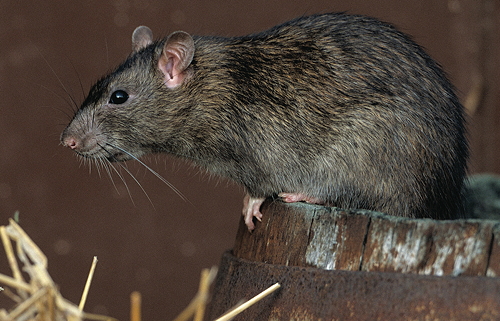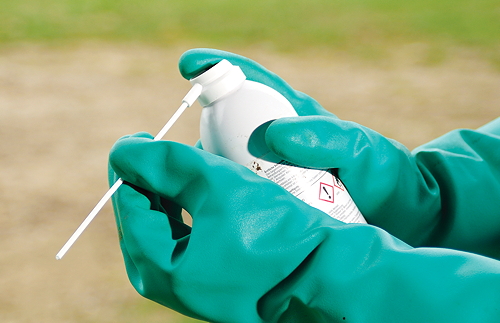With large rodent populations being recorded this year, pig farmers are urged to ensure they have a planned, integrated control programme at the top of their agenda. Bayer’s rural hygiene manager, Ken Black, discusses the challenges posed by rodents, and outlines his top tips for beating them
Pig units provide ideal conditions for rodent survival. In turn, rodents present a big challenge on units because they can multiply so quickly, contaminate feed, spread disease and damage equipment.
Mice pose one of the major problems and are often overlooked. In a six month period, just one mouse can eat more than 1kg of food and contaminate a further 20kg, leading to significant losses. Mice can live up to two years, during which time a single animal will produce about 60,000 droppings and 150 litres of urine, presenting a real risk of contamination.
Rats are just as hazardous, with an infestation of 200 rats able to consume nearly 1,100kg of feed in a year. Alongside the threat they pose to feed stocks, they also carry infectious diseases such as Leptospirosis (Weil’s disease) which is spread through infected rat urine, and is a very serious health risk to those who work on the farm. They can also carry disease from unit to unit, when searching for nesting sites and food sources.
The estimated cost to UK farmers from rodent damage is between £16 and £25 million every year, with more than 20% of farm fires being caused by rodents gnawing through electrical cables.
Think like a rodent
It’s vital to know what type of pest is being dealt with, as control programmes will differ depending on whether the target pests are rats or mice. A rodent control plan that works for rats won’t necessarily work for mice.
They’re different species with very different behavioural habits, and you essentially need a control plan for each. That’s not to say there isn’t an element of cross over. Some actions a farmer can undertake will help control both, but fundamentally they need to be treated as two separate problems.
Rats don’t usually move great distances and tend to spend most of their lives on the ground, feeding from two to three familiar points, mostly at night. They’re neophobic, meaning they don’t like anything new in their environment, and therefore will avoid new bait stations until they’re confident of their safety, which can take more than 10 days.
Conversely, mice are very inquisitive and spend up to 70% of their time off the ground. They will actively investigate objects, and feed in many different sites, up to 20 to 30 each night.
Rodents come onto pig units in search of somewhere safe and secure to live and breed, and where there’s a source of food. Areas of cover and overgrowth are attractive to them, although mice will live almost exclusively in an indoor environment. Rats venture further afield, but tend to prefer areas close to buildings that have good cover, as they don’t like travelling across open ground. Look out for well-established routes they use to move between burrows and feeding sites.
Before turning to rodenticides, habitat management and good housekeeping are crucial as baiting alone won’t be sufficient.
Ensure boundary areas are clear and tidy, and sheds are secure, to prevent rodents gaining access. It’s also important to remove all food and water sources where possible, including clearing spilt feed. If these are removed, the environment will appear less attractive to rodents.
Be vigilant
Plan ahead and be vigilant for rodents on your unit. Be proactive rather than reactive – don’t give them an opportunity to move in – and apply an integrated rodent management strategy.
Any areas where food sources are present are likely to attract rodents, such as feed silos and any machinery used to move or transport feed. It’s also important to protect wiring and electronic systems, prone to gnawing damage by rodents, both within machines and in buildings. This is to ensure the safety of farm staff, prevent fires and to avoid costly repairs the following season.

After these measures have been applied, and if a rodenticide is still needed, the correct choice of bait formulation is key. It’s important to understand bait choice and know what options are available, as not one formulation will suit all situations.
The correct choice of rodenticide for the particular baiting situation is important. On pig units, rodenticide baits are up against tough competition from high-quality food sources that are readily available, so food baits need to be highly palatable and attractive to the target pest.
Bayer’s Rodilon has been developed in four palatable formulations: Wheat Tech, Trio, Soft Blocks and Blocks, each enabling the user to choose a bait that’s most suited to the environment or the target pest. It contains difethialone, which is the first new rodenticide active for over 20 years.
Rodilon Trio, which is unique to the UK market, has been developed to be in tune with a mouse’s diet. It contains a mixture of oat grains, sunflower seeds and maize, ingredients that are chosen for their known palatability to mice. It’s also made using a unique “turbo impregnation” manufacturing process that infuses the active ingredient right into the core of the bait. This plays an important role because mice will remove the husk from the grain before eating it.
Two out of the four Rodilon formulations have been designed specifically to appeal to a rat’s feeding habits. Rodilon Wheat Tech is a whole-grain bait that also includes “turbo impregnation”, while Rodilon Blocks is made from high-food grade ingredients and has multiple edges, designed to encourage a rat’s gnawing habits. These bait blocks incorporate a hole in the middle so they can be secured with wire and cannot be carried away. This is vital, yet often overlooked. If rodents carry bait off, the farmer has no idea whether it’s actually been eaten, and it can also pose a risk to non-target species.
The fourth and final formulation in this range, Rodilon Soft Blocks, is made from food-grade ingredients that use texture and blending to make it the most palatable to both rats and mice. It’s ideal for control where there are other competitive food options available.
Water-based foam
Racumin Foam is a new rodenticide from Bayer that offers an alternative product for rodent control throughout the UK and Ireland. This product is a specialised water-based foam formulation containing the active ingredient coumatetralyl. It’s an anti-coagulant that works using the rodent’s natural grooming habits, taking away the issue of bait palatability.
The foam can be placed in areas where the rodents are known to pass, such as access holes, cavity walls and enclosed runs. It’s then transferred to the pest’s coat as it brushes past, and is ingested straight into its blood stream during routine grooming, so there’s no reliance on the bait being eaten.
It’s a flexible, innovative and effective new rodenticide, ideal for use where bait shyness, other food sources, or neophobia prove barriers to gaining control.
Finally, don’t forget that once an infestation has been controlled it’s important to collect spent bait and dead carcases. Always monitor for new activity and be prepared to start a new baiting programme as there’ll still be new rodents waiting to move into the same territory.
The most effective weapon in a farmer’s arsenal is strategy. Without the inclusion of integrated control measures, combined with a tailor-made baiting approach, effective control is difficult to achieve, whatever the size of infestation.
For more information visit: www.pestcontrol-expert.com




